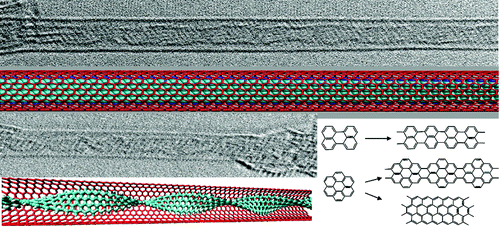Graphene nanoribbons grown inside carbon nanotubes develop electronic properties
September 29, 2011

Graphene nanoribbons encapsulated in single-walled carbon nanotubes were synthesized using confined polymerization and fusion of polycyclic aromatic hydrocarbon molecules (credit: Aalto University)
Researchers in Finland and Sweden have figured out how to join two of the most promising nanomaterials — graphene and single-wall carbon nanotubes (SWNTs) — to function as semiconductors and other electronic circuit components.
Small pieces of graphene were used as building blocks for long and narrow nanoribbons inside the nanotubes.
The researchers found that the properties of the graphene nanoribbons can be changed, depending on their width, making them either metallic or semiconducting. And SWNTs can also be semiconducting or insulating, depending on how they are chemically modified.
For example, the researchers said, a metallic nanoribbon inside an insulating nanotube can be a thin, insulated nanowire. Or nanoribbons can be used directly inside of SWNTs to generate light as light-emitting diodes. Semiconducting nanoribbons could be used for transistor or solar cell applications. Or a metallic combination could produce a new kind of coaxial nanocable for use in transmitting radio signals.
“Precise control of the width and angle of the graphene nanoribbons will help assembly of materials based on graphene, with strict control of the band gap (to function as insulating, semiconducting, or conducting). Such control is not possible for graphene obtained by traditional technology,” said Ilya Anoshkin, a research associate at Aalto University.
The researchers added that the synthesis of the two materials is simple, scalable, and allows the graphene nanoribbons to keep their unique properties while inside the nanotubes.
Ref.: Alexandr V. Talyzin, et al., Synthesis of Graphene Nanoribbons Encapsulated in Single-Walled Carbon Nanotubes, Nano Letters, 2011; [DOI: 10.1021/nl2024678]